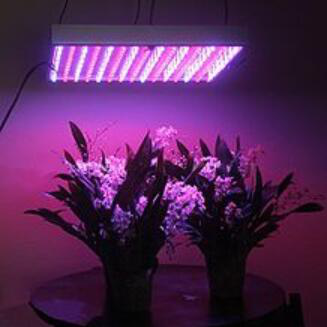Home >> News >> Company News

Two plants under the growth of luminescent LEDs.
LED illuminators consist of light-emitting diodes, usually in a housing with a heat sink or built-in fan. LED lights usually do not require a separate ballast and can be plugged directly into a standard power outlet.
LED growth lamps vary depending on the application. It is known from the study of photomorphogenesis that green, red, far-red and blue light spectra have an effect on root formation, plant growth, and flowering, but there is not enough scientific research or field testing to recommend specific color ratios using LED growth lamps. It has been shown that many plants will grow normally if red and blue light are applied. However, many studies have shown that red and blue light provides only the most cost-effective growth method, and that plant growth is still better under light-supplemental green.
The white LED growth lamp provides a full spectrum designed to mimic natural light and provide plants with a balanced spectrum of red, blue and green. The spectrum used is different, but the white LED growth lamps are designed to emit a similar amount of red and blue light, and to added green light will appear white. White LED illuminators are commonly used for supplemental lighting in homes and office spaces.
A large number of plant species have been evaluated in greenhouse trials to ensure that plants have higher quality in biomass and biochemical composition, even comparable to field conditions. The plant performance of mint, basil, lentils, lettuce, cabbage, parsley, and carrots was measured by assessing the health and vitality of the plants and the success of growth. Promote the selection of large quantities of ornamental plants.
In the LED growth lamp test conducted by Philips Lighting, in order to find the best light formula in the greenhouse to grow various vegetables, they found that the following aspects of light affect plant growth photosynthesis and plant development morphological light intensity, total light changes with time At what time of the day, (spectrum), light direction and light are distributed on the plant. However, it is worth noting that in the test between tomatoes, mini cucumbers and sweet peppers, the best recipes for all plants are different, depending on the crop and region, so they must now optimize the greenhouse according to the test. LED lighting and errors. They have shown that LED light affects disease resistance, taste and
andnutritional levels, but by 2014 they have not found a practical way to use this information.
The diode design for the initial LED light-emitting diode is typically 1/3 watt to 1 watt. However, LED growth lamps now typically use higher power diodes, such as 3 watts and 5 watts wattdiodes. For highly compact areas, COB chips between 10 watts and 100 watts can be used. These chips are generally less efficient due to heat dissipation.
LED growth lights should keep the plants at least 12 inches (30) away from the plants to prevent leaf burn.
Previous: Chromatography
Next: Plant Growth Lamp